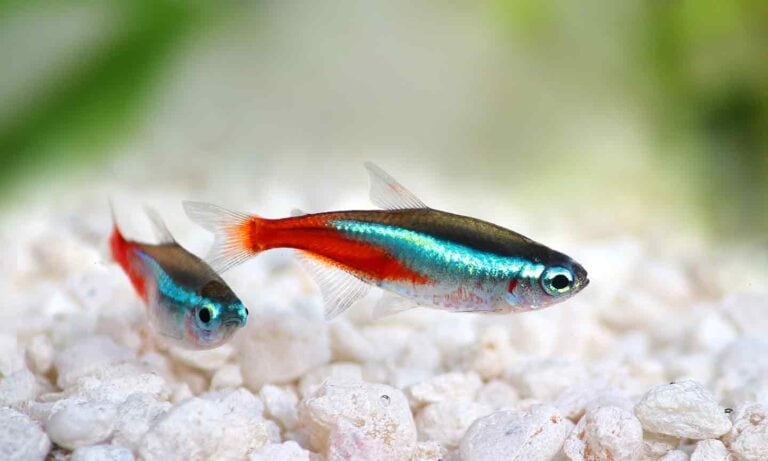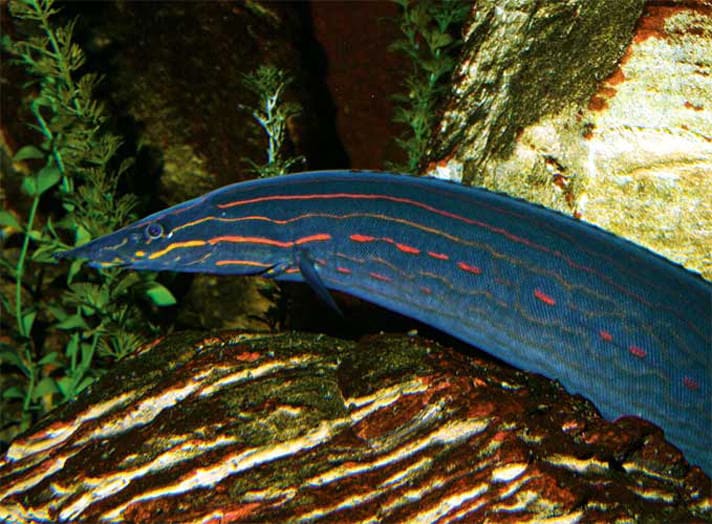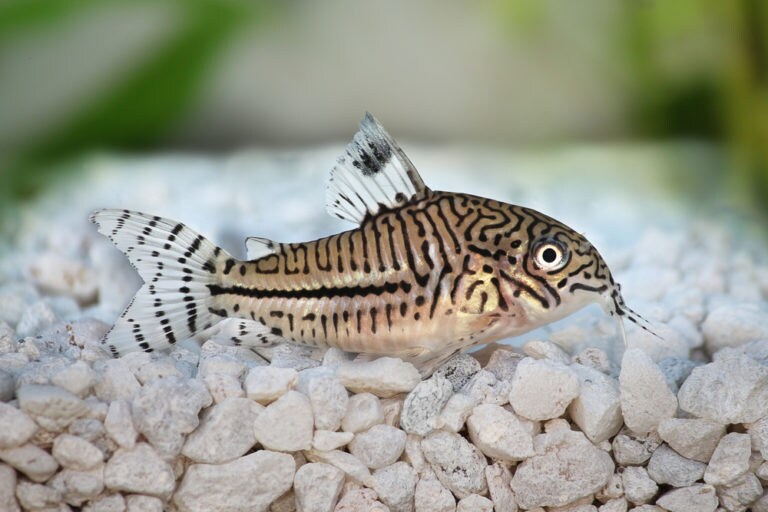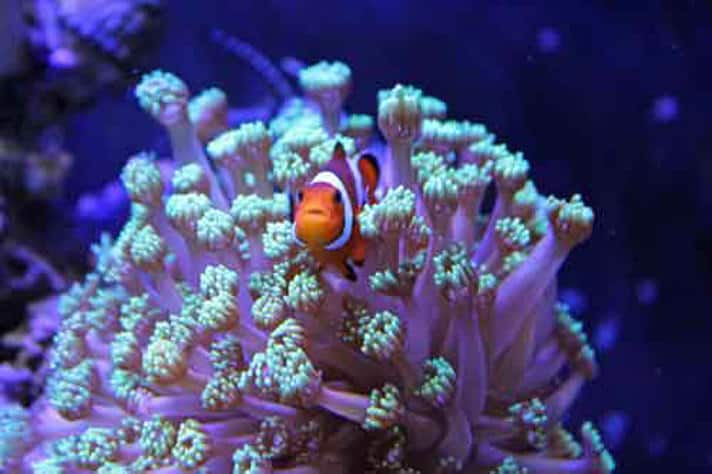We’ve all heard that old joke about “jumbo shrimp” being the ultimate oxymoron. Freshwater shrimp, however, just might be the next fad in the home aquarium. With just a little bit of work, you can set up a shrimp aquarium that’s easy to care for and a lot of fun to watch.
I’ve found grass shrimp when collecting native fish in Missouri, long-arm shrimp (Paratya australiensis) while collecting rainbowfish in Australia and Macrobrachium lar while collecting in New Guinea. There are shrimp to be found just about all over the world, and many of them will work quite nicely in home aquariums.
Many collectors of fish for the aquarium trade finally realize there is now a market for some of these shrimp that are showing up in their nets along with fish. Aquarists in North America are now catching on to what the Japanese and Taiwanese have been doing for years: keeping and breeding shrimp. Although some of the shrimp found in the market today are natural species, many are carefully crafted color morphs that have been painstakingly bred to produce a fantastic variety of choices for the home aquarium.
When looking at photographs I’ve taken over the years, I realize I’ve kept some form of freshwater shrimp for more than 10 years. My first “exotic” shrimp was the bright orange wood shrimp (Atyopsis moluccensis). These are a sight to behold as they spread their tiny fans in a current in their aquarium, hoping to snag a tasty morsel. The Amano shrimp (Caridina japonica) have been very popular with the planted aquarium crowd and are a real workhorse at removing algae. Until recently, you had to buy both of these shrimp from wild-caught stock, as it seemed impossible to raise the young. There are now credible articles on breeding the Amano shrimp (e.g., Mike Noren piece, see “Online References” sidebar) and maybe someday soon we’ll hear something on the successful breeding of a wood shrimp.
Three or four years ago, the bright red cherry shrimp (Neocaridina denticulata sinensis) hit the United States with a bang. One of the first easy-to-keep shrimp, it could also be bred in the aquarium. Unlike Amano shrimp, the eggs hatch immediately into tiny versions of the adults and do not go through a complex free-swimming larval stage. Just keep their water clean, and feed them flake food, and you get a lot of babies. I add baby cherry shrimp to my rainbowfish fry aquariums. They scour the bottom eating any leftover food and help to keep the aquarium spotless. Except for keeping them with baby rainbowfish, I tend to keep my red cherry shrimp in their own aquarium.
Now the floodgates for new shrimp varieties have burst on the North American market, giving us dozens of new ones to pick from. You can find Caridina sp. “Tiger,” “Bee,” “Crystal Red,” “Blue” and “Rainbow”; Neocaridina palmate is another one to consider. Some of these are most likely color morphs of the same species, but many have been identified as true species.
If you enjoy larger shrimp, there are also long-arm shrimp that are gaining in popularity. You may have to be cautious with these, though, as they do have claws or chelipeds and are capable of catching small fish, especially at night. I’ve kept the Indian whisker shrimp (probably Macrobrachium lamarrei lamarrei), which stay fairly small. The females are especially pretty when berried (carrying eggs under their tail), with their green eggs. I have also kept a larger Macrobrachium species that often comes in labeled “Tiger shrimp,” which is probably Macrobrachium sp. “red claw.”
Caring For Shrimp
When it comes to fishkeeping, seeking out information before making a purchase is usually recommended. Although there’s a lot of information on the Internet about aquarium fish, some of it is incorrect, and you usually have to figure out what is right and what is not. With shrimp, there really isn’t a good book I know of that can give a good starting point on keeping and rearing freshwater species.
Websites are listed in the “Online References” sidebar that should help in finding information. Note that the European websites are much further ahead of anything one finds on North American sites. Even if some of the sites in Europe can’t be read or translated, they can help identify unusual shrimp found at local pet stores. You may find that no matter how hard you look, you will be unable to identify the shrimp you see online or at a fish store. With so many new varieties showing up, it’s quite difficult to identify some of them.
For the most part, shrimp — especially smaller ones — should be kept in aquariums without fish. Amano shrimp and wood shrimp can certainly be kept in aquarium with smaller, peaceful fish, but smaller shrimp just do better in an aquarium by themselves. Although small fish may not eat the adults, they will surely snack on the baby shrimp. Keeping and growing my colonies is one of my goals, so I give them an aquarium of their own. Many of the varieties will cross-breed, so to keep the colors or strains pure, house them in separate aquariums.
A 10-gallon fish aquarium is an ideal size for most of the shrimp currently available. Aquariums smaller than 10 gallons might not be as stable in terms of water quality and should probably be avoided. Even the slightest mishap when feeding can lead to an ammonia spike that can spell disaster in a smaller aquarium. Shrimp are much less tolerant of poor water conditions than most fish.
Ammonia, nitrites and nitrates will eventually kill the shrimp, even if only a small amount of uneaten food remains in the aquarium. For biological filtration, I use elevated air-driven sponge filters with a medium to slow air flow. As for substrate, I’ve used fine-grain gravel and also white silica sand. For some species, such as the hardy red cherry shrimp, you can use coral sand or gravel, as they enjoy a more alkaline environment. Slower-growing plant species, such as Java moss and Java fern, work pretty well in a shrimp aquarium. I think using fast-growing plants in a shrimp aquarium is probably a mistake because they tend to suck up needed nutrients. This suggestion had been made on the Petshrimp forum (www.petshrimp.com), and I realized it was probably the reason my cherry shrimp colony hadn’t been as prolific recently. When I removed the fast-growing plants and went back to Java moss, my shrimp did much better and I started seeing a lot more baby shrimp in the aquarium.
Water Parameters
Some of the newer shrimp available like soft, acidic water with temperatures in the mid 70s (Fahrenheit); others prefer a more alkaline pH and harder water. For each shrimp, you’ll have to do some research or avoid the extremes to start with.
Shrimp need clean water, so try to change 30 percent at least once every two weeks, and it’s better if changes are performed weekly. Shrimp are especially sensitive to chlorine or chloramines in city water supplies, so it’s important to use a dechlorinator or ammonia neutralizer to remove these chemicals. Quality products that neutralize ammonia are important. If chlorine and/or ammonia aren’t eliminated, the shrimp will die. Invertebrates — especially shrimp — are very sensitive to copper. Never treat an aquarium with any copper-containing product if the aquarium houses shrimp. It has been suggested that there might even be too much copper released from home water pipes when mixing hot water to equalize the temperature of replacement water. So far, my shrimp have not adversely reacted to water changes.
Copper is not the only thing that can harm shrimp. Many of the antiparasite products on the market will have devastating results on shrimp, so this is just another good reason to have a shrimp-only aquarium. If fish are to be kept with the shrimp, put the fish in a quarantine aquarium first for several weeks before introducing them to the display aquarium so that any disease that would require antiparasite medications can be dealt with there.
Feeding Shrimp
Healthy shrimp skitter all over an aquarium, constantly searching for food. They seem to never hold still and are always moving about. When food is dropped into the aquarium, they soon sense it and scurry to the front of the aquarium to eat. Shrimp will drop their shell (molt) every once in a while. It takes a day or two after the molt for their new shell to harden, and they will usually try to stay hidden from predators during this time. They are extremely vulnerable during this process, which is another good reason to keep fish out of their aquarium.
Shrimp will do fine on basic fish food — pellet or flake. Feed only an amount that can be eaten in a few minutes. Shrimp will also find their own food when aquatic plants like Java moss and Java fern are growing in their aquarium. Many shrimpers advocate putting waterlogged dead oak leaves or other leaf varieties in the aquarium as a source of food for the shrimp. Make sure that the leaves have been soaked for several weeks before adding them to the aquarium to ensure that most of the tannins have leached out. The leaves slowly decay, and the shrimp seem to feed on both the leaves and the other organisms that break down the leaves.
Dwarf Shrimp
To ensure that a breeding colony can be established, it is suggested that six or more shrimp be purchased at the same time. A group of 10 shrimp would be a better starting point for dwarf shrimp. Once the colony reaches about 50 individuals, it’s time to start selling a few online or back to the local store.
Red Cherry Shrimp (Neocaridina denticulata sinensis var. “red”)
The red cherry shrimp is the perfect beginner shrimp. It is adaptable to a lot of water conditions and not as picky as some of the other varieties.
Bee Shrimp, Crystal Red Shrimp, Chinese Zebra Shrimp and Tiger Shrimp
These are all either the same species, Caridina serrata, or are from a closely related group. Because they are so closely related, they should be kept in separate setups to avoid cross-breeding and losing their distinctive colors. All enjoy fairly soft, slightly acidic water.
Bumblebee Shrimp (Caridina sp.)
The bumblebee shrimp is another shrimp that does better in soft, slightly acidic water.
Long-Arm Shrimp
To ensure that both males and female long-arm shrimp (Macrobrachium) are obtained, buy at least six. Because long-arms get a lot bigger, and display more aggression, an aquarium larger than 10 gallons may be necessary to keep them doing well.
Indian Whisker Shrimp (Macrobrachium sp., probably M. lamarrei lamarrei)
These shrimp are about 2.5 inches in size. Easy-to-keep, they should be kept in moderately hard (110 ppm) water at a pH of 6.8 to 7.0. A 10-gallon aquarium would probably work fine for this variety.
Zebra Shrimp (Macrobrachium sp.)
These are probably from the “red claw” complex of shrimp. The males get to more than 3 inches, and zebra shrimp are easy to keep and breed. These shrimp are capable of catching fish, so they should be kept by themselves.
I hope I’ve given you some ideas on what it takes to set up and successfully keep a shrimp aquarium. They are a lot of fun to watch, and you will soon find yourself wanting to set up a second and then a third aquarium. Before long, you too will have “shrimp fever”!
Posted By: Chewy Editorial
Featured Image: Via Gary Lange
Share:










